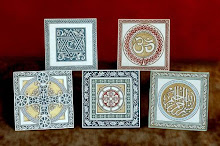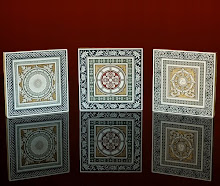 |
| There's no place like Aum |
"What is this symbol?" a visitor to the booth asks. Well, it's said to be the first sound of the universe or some people refer to it as the yoga symbol. An utterance evoking peace and meditation. Ahh-who-mmm- ending with a humming sound and then silence. The silence is important and counts as the fourth sound of the syllable. It is necessary to be aware of stillness. The focus is on the vibration and then the silence and stillness between the chants of ahh-who-mmm- . Once I sound out the syllable, the person instantly recognizes it but still knows little of its origin or meaning.
Some even confuse the flowing script as Arabic. This particular Aum is in the Devanagari script. Sanskrit was an oral tradition way before it was written and became more of a liturgical language. There are other scripts that the Aum is written in which is why you may notice a difference in the way it is depicted. Artists also take liberties as they create the many representations of the syllable that you see in jewelry, bags, tattoos, t-shirts, etc.
The Aum, in Hindu belief, is in use daily. Hindus begin their day, work or any journey by uttering and chanting Aum. A new born child is washed, then the sacred syllable is written on their tongue in honey. It is not a word but rather an intonation and like music, with proper intonation, can resonate throughout the body so that the sound penetrates to the center of one's being. The past, present and future are all included in this one sound.
Jeff and I chose to refer to the syllable in English as Aum. Some visitors to our booth will correct me and say that it should be written as Om. Both are equally accepted so I will continue with Aum in this writing and on our labels.
The label on the tile back simply reads:
Charged with religious energy, this most sacred of Sanskrit syllables is often articulated at beginning and end of recitations and prayers. Early noted evidence of AUM (Om) use occurs in the Hindu text Rgveda, and dates in practice to at least 1200 BCE.
Rgveda is a Sanskrit compound of "praise,verse and knowledge". The Rgveda Sanskrit qualifies as one of the earliest of the Indo-European language family which includes English and most European languages.
This is certainly a "nutshell" version of what Aum is. The depth and breadth of this syllable is awe inspiring and will take a great deal of meditation to more deeply understand and to feel even a portion of the power that it contains.
A young child bought our Aum art tile as a birthday gift for his mother who was turning 35. I can now hardly look at the Sanskrit writing of the Aum without seeing the 35 that the child saw. As I reflect on the powerful vibrations of this syllable I remember his joyful purchase. "Aum is where the heart is."




